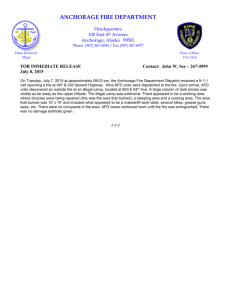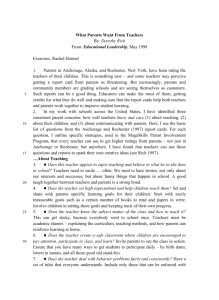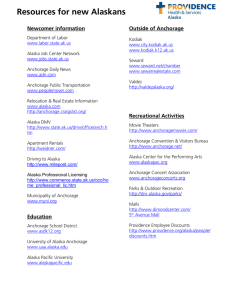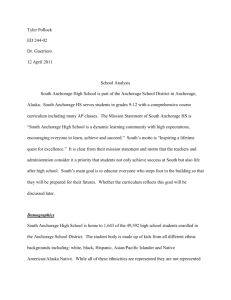Conceptual Stage Relocation Study and Assessment
advertisement
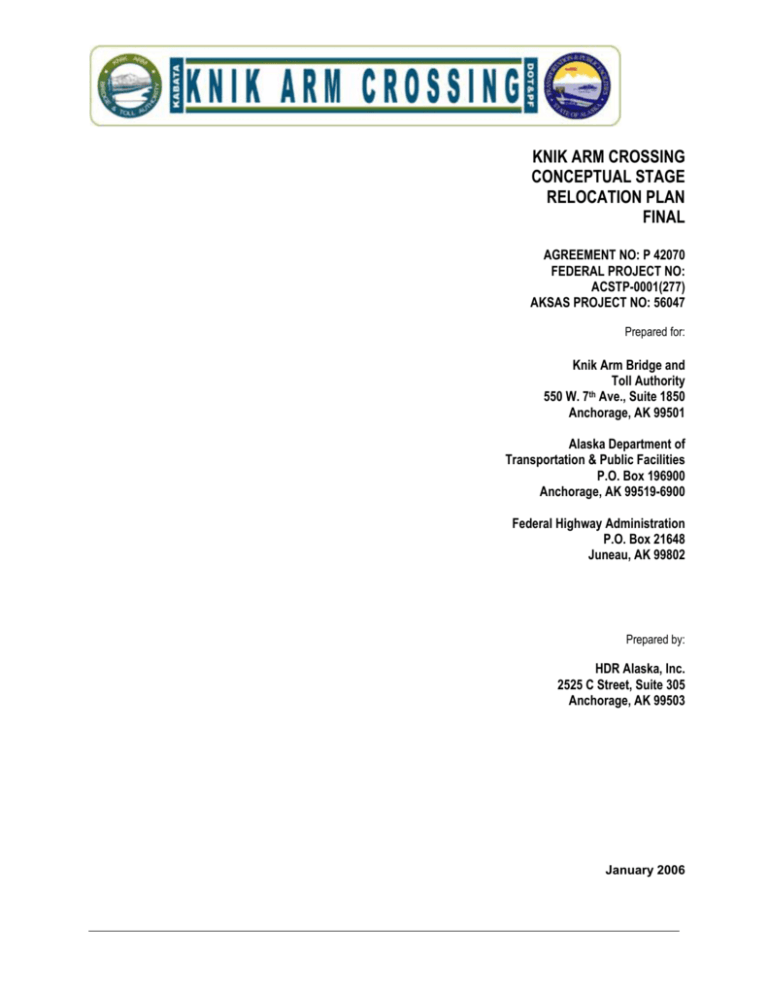
KNIK ARM CROSSING CONCEPTUAL STAGE RELOCATION PLAN FINAL AGREEMENT NO: P 42070 FEDERAL PROJECT NO: ACSTP-0001(277) AKSAS PROJECT NO: 56047 Prepared for: Knik Arm Bridge and Toll Authority th 550 W. 7 Ave., Suite 1850 Anchorage, AK 99501 Alaska Department of Transportation & Public Facilities P.O. Box 196900 Anchorage, AK 99519-6900 Federal Highway Administration P.O. Box 21648 Juneau, AK 99802 Prepared by: HDR Alaska, Inc. 2525 C Street, Suite 305 Anchorage, AK 99503 January 2006 Knik Arm Crossing Conceptual Stage Relocation Plan Table of Contents Executive Summary ........................................................................................................................ 1 1.0 Introduction ........................................................................................................................ 2 2.0 Project Description ............................................................................................................. 2 2.1 Description of the Proposed KAC Project Study Area............................................. 4 2.2 Alternatives............................................................................................................... 6 2.3 Preferred Alternative ................................................................................................ 6 3.0 Methodology ...................................................................................................................... 7 4.0 Affected Area ..................................................................................................................... 8 4.1 The Mat–Su .............................................................................................................. 8 4.2 Southern Alignment Bridge Alternatives ................................................................. 8 4.3 Anchorage................................................................................................................. 8 4.3.1 Characteristics of Affected Community ......................................................... 8 5.0 Impacts and Environmental Consequences ........................................................................ 9 5.1 Direct and Construction Impacts .............................................................................. 9 5.1.1 No-Action Alternative .................................................................................... 9 5.1.2 Mat-Su Approach Alternatives ....................................................................... 9 5.1.3 Southern Alignment Alternatives ................................................................... 9 5.1.4 Anchorage Approach Alternatives.................................................................. 9 5.1.5 Housing Resources ....................................................................................... 12 5.1.6 Business, Farm, and Non profit Resources................................................... 13 5.1.7 Temporary versus Permanent Displacements............................................... 13 5.2 Mitigation Measures and Permit Requirements ..................................................... 13 6.0 References ........................................................................................................................ 15 List of Tables Table 1. Displacement summary ................................................................................................... 12 Table 2. Residences for sale in $200,000 to $300,000 price range ............................................... 12 Table 3. Anchorage rental housing availability............................................................................. 13 List of Figures Figure 2.1. Proposed Project Route..................................................................................................3 Figure 2.2. KAC Draft EIS Study Area............................................................................................5 i Knik Arm Crossing Conceptual Stage Relocation Plan Executive Summary The Knik Arm Bridge and Toll Road project would create a new crossing over the Knik Arm, reaching from Point McKenzie in the Mat-Su Borough to Anchorage, and would increase access to portions of the Mat-Su Borough from the Municipality of Anchorage for commuter, commercial, and freight movement. It would also bring the recreational lands of Mat-Su closer to the population of Anchorage. This report focuses on the families, non-profit organizations, farms, and businesses that will be displaced by the project. ”Conceptual stage plan” is the term of art used for this technical report. It was prepared for use during project alignment studies and as a part of the environmental analysis of the proposed KAC project. Two future relocation steps would take place during planning for this project: • • At the time real estate acquisition would commence for each phase of work, an acquisition stage plan would be prepared for those properties. This planning would generally commence with individual interviews of each family and business/non-profit organization/farm to be displaced. Then, in conjunction with each parcel acquisition, a detailed statement of benefits would be provided each displaced person based upon the circumstances at the time the acquisition of the property is started. The project would require the acquisition of new rights of way in both Mat-Su Borough and the Municipality of Anchorage. The relocations caused by each alignment were evaluated. The charts below summarize the levels of displacement identified for each of the route segments or alternatives. The relocation impacts of this project would be most heavily focused upon the Government Hill Community within the Municipality of Anchorage. This historic district, as the first community of Anchorage, is the crossroads of the area and presently serves as the portal to Elmendorf Air Force Base. The project design alternatives through Government Hill would be placed in a tunnel, a design that minimizes the permanent displacements by the project. 1 Knik Arm Crossing Conceptual Stage Relocation Plan 1.0 Introduction This Technical Report provides documentation of the Conceptual Stage Relocation Plan, in the Matanuska-Susitna Borough (Mat-Su) and the Municipality of Anchorage (Anchorage) that would be affected by the proposed Knik Arm Crossing (KAC) project. The Federal Highway Administration (FHWA) is preparing a Draft Environmental Impact Statement (EIS) as part of the National Environmental Policy Act (NEPA) process to evaluate a Knik Arm crossing sponsored by the Knik Arm Bridge and Toll Authority (KABATA). This Technical Report is limited to the Study Area and to the alternatives further evaluated in the EIS. The Study Area, the proposed alternatives, and the projected impacts from their implementation are described below. 2.0 Project Description More than 80 years of transportation, land use, and economic plans and studies for the Upper Cook Inlet region of Alaska have addressed the need for a Knik Arm crossing project to connect Anchorage with the Mat-Su. In 2003, the Alaska State Legislature established the Knik Arm Bridge and Toll Authority (KABATA) as a public corporation and an instrumentality of the State of Alaska within the Alaska Department of Transportation and Public Facilities (ADOT&PF). The specific mission of KABATA is to “… develop, stimulate, and advance the economic welfare of the state and further the development of public transportation systems in the vicinity of the Upper Cook Inlet with construction of a bridge to span Knik Arm and connect the Municipality of Anchorage and the MatanuskaSusitna Borough.” (Alaska Statutes chapter 19.75) In accordance with this mission, the purpose of the proposed KAC project would be to provide improved access and connectivity between Anchorage and the Mat-Su through an efficient and financially feasible crossing of Knik Arm, including adequate connections to the committed roadway network on both sides of Knik Arm. A Knik Arm crossing would: • improve regional transportation infrastructure to meet existing and projected population growth in Upper Cook Inlet • enhance the movement of people, freight, and goods between Anchorage, the Mat-Su, and Interior Alaska • offer safe, alternative connections between regional airports; ports; hospitals; and fire, police, and disaster relief services for emergency response and evacuation The proposed bridge crossing of Knik Arm would be located approximately 1.25 miles north of Cairn Point and would span approximately 2.5 miles (see Figure 2.1). The roadway connection on the Mat-Su side of Knik Arm would be Point MacKenzie Road near the Port MacKenzie District. The roadway connections on the Anchorage side of Knik Arm would be the A-C and Ingra-Gambell Couplets, generally in the Port of 2 Knik Arm Crossing Conceptual Stage Relocation Plan Anchorage (POA)/Government Hill/Ship Creek area. The total length of the project from the intersection of Point MacKenzie and Burma Roads to the intersections of the A-C and Ingra-Gambell Couplets with Third Avenue would be approximately 19 miles. Design and construction features of the proposed KAC project would include, among other details: • a toll plaza • a rural principal artery • phased construction The proposed project would be a controlled access toll facility with a toll plaza located in the Mat-Su near the western bluff of Knik Arm. The proposed project would be classified as a rural principal arterial in the Mat-Su and across Knik Arm, transitioning to an urban principal arterial in Anchorage in the vicinity of the POA. The proposed project would be phase-constructed as travel demand would warrant and would be anticipated to generally be an initial two-lane facility with expansion to a four-lane facility by the design Figure 2.1 shows that the proposed project begins year 2030. Initial construction would at Burma Road and ends in Downtown Anchorage. include a connection to the existing Components common to all routes being considered are also identified. A-C Couplet on the Anchorage side and, by approximately 2022–2025, a connection to a new viaduct (elevated bridge) across the Ship Creek rail yard to connect with the Ingra-Gambell Couplet. Right-of-way (ROW) widths for the project would vary by specific design element. The proposed project ROW in the Mat-Su would be approximately 400 to 450 feet in width. In the Anchorage portion of the proposed project, the ROW would be approximately 260 feet along the east shore of Knik Arm down to the future expansion of the POA, and then vary from 200 to 350 feet as it passed behind the port. As it climbed Government Hill, the ROW would expand to 985 or 585 feet wide to accommodate a cut-and-cover tunnel and access points along either a Degan Street- or Erickson Street-area alignment, respectively. Continuing southward it would cross the Ship Creek rail yard along an approximately 80-foot-wide, pier-supported viaduct ending at Third Avenue, the proposed project terminus. 3 Knik Arm Crossing Conceptual Stage Relocation Plan 2.1 Description of the Proposed KAC Project Study Area The Study Area for the proposed KAC project is located within the boundaries of Anchorage and the Mat-Su in the Upper Cook Inlet region of Southcentral Alaska (Figure 2.2). The Study Area has a combined population of nearly 350,000, which represents over 50 percent of Alaska’s total population. The Anchorage and Mat-Su portions of the Study Area are separated from one another by Knik Arm, a 30-mile-long waterway, which varies in width from 2 to 6 miles. Anchorage is located approximately 3 miles across Knik Arm from Port MacKenzie and the adjacent Port MacKenzie District. Although the physical separation between these two areas consists of a short span of waterway, the only current surface transportation access between Anchorage and the Port MacKenzie District (Port District) is by 80 miles of existing roadway around the head of Knik Arm. Located along the eastern shore of Knik Arm, Anchorage encompasses 1,961 square miles, 84 percent of which is occupied by National Forest, State Parklands, and tidelands, with an additional 6 percent occupied by military reservations. Only about 10 percent of the entire municipality is inhabited and available to accommodate existing and future growth. Most residents of Anchorage live in the Anchorage Bowl, the most urbanized portion of the municipality. The Anchorage Bowl occupies approximately 112 square miles and is bounded by Chugach State Park, Knik and Turnagain Arms, Elmendorf Air Force Base (Elmendorf), and Fort Richardson Military Base (Fort Richardson). Anchorage residents outside the Anchorage Bowl live either further north in the suburban communities of Chugiak-Eagle River or in small residential areas along the Glenn Highway and Turnagain Arm. Also located within this portion of the Study Area are the POA—a vital intermodal facility—and the adjacent Ship Creek industrial area. On the western shore of Knik Arm, the Mat-Su consists of an area of 24,683 square miles, which encompasses approximately 23 percent of all private land in the state of Alaska. Because there is a substantial amount of undeveloped land available in the Mat-Su, the area provides an alternative to more costly and limited residential, commercial, and industrial lands within Anchorage. This availability has resulted in numerous changes that have recently occurred or will be occurring in the Mat-Su, including construction of Port MacKenzie in the late 1990s, existing and planned expansion of the connecting transportation network to and from Port MacKenzie, and planned development of the 9,000-acre Port District. The Mat-Su Borough is also developing a ferry link between Port MacKenzie and the POA; the ferry is projected to begin operation in 2008. 4 Figure 2.2. KAC Draft EIS Study Area. The Study Area has no specific, fixed boundaries because the Study Team has created a unique Study Area for each resource or issue assessed in the Draft EIS. The term Study Area, thus, has a context-specific meaning that shifts from one resource to another. 5 Knik Arm Crossing Conceptual Stage Relocation Plan Knik Arm Crossing Conceptual Stage Relocation Plan 2.2 Alternatives The proposed KAC project would begin at the intersection of Point MacKenzie and Burma Roads and follow the existing roadway alignment south to the western boundary of the Port District. From here, there would be two alternative routes for getting to the proposed bridge crossing. The proposed Point MacKenzie Road Alternative would use the existing Point MacKenzie Road most of the way through the Port District before deviating from the established road and heading toward the proposed bridge crossing near the western bluff. The proposed Northern Access Alternative would skirt the core port area on the north side on a new alignment. With either proposed alternative, there would be a toll plaza and intersection/access road to allow access to and from Port MacKenzie. The proposed bridge would be within the Southern Alignment, a corridor beginning approximately 1,500 feet south of Anderson Dock on the Mat-Su side and ending 1.25 miles north of Cairn Point on the Anchorage side. The crossing structure would be either 8,200 or 14,000 feet long. The Southern Alignment also includes the eastern bridge abutment, where the proposed Anchorage approach road would travel southwest on fill along the tidelands and below the bluff (termed the proposed “Below-the-Bluff Roadway”), toward Cairn Point, then turn southward, closely following the natural curve of the shoreline. From this point the proposed roadway would parallel the eastern boundary of the POA, where the route would connect to the existing A-C Viaduct and the proposed IngraGambell Viaduct by way of either of two routes: the Degan Alternative or the Erickson Alternative. The proposed Degan Alternative would follow the alignment of Degan Street through a cut-and-cover tunnel that would initially connect to East Loop Road with an atgrade, T-intersection (Phase 1). As travel demand would warrant, the route would continue on the proposed new Ingra-Gambell Viaduct over the Ship Creek rail yard before tying into the Ingra-Gambell Couplet at 3rd Avenue. At that time, Loop Road would be elevated over the proposed KAC route to provide access to Government Hill and Elmendorf. The proposed Erickson Alternative would be similar, but the cut-andcover tunnel would align with Erickson Street and connect directly into Loop Road in Phase 1 (ramps would continue to provide access to Government Hill and Elmendorf). In Phase 2, when travel demand would warrant, the route would continue in a parallel cutand-cover tunnel under Erickson Street onto the proposed Ingra-Gambell Viaduct, tying into the Ingra-Gambell Couplet at 3rd Avenue. 2.3 Preferred Alternative FHWA screened the range of alternatives against criteria for purpose and need and technical criteria to identify reasonable alternatives for detailed study in the Draft EIS. Based on these screening criteria and subsequent detailed evaluations, FHWA has identified a Preferred Alternative. The preferred approach route to the proposed Knik Arm Bridge from the Mat-Su side is the Northern Access Alternative: Point MacKenzie Road from its intersection with Burma Road, south to the Port District, and connecting through to the Port District along 6 Knik Arm Crossing Conceptual Stage Relocation Plan the northern alignment. FHWA chose this route because it would avoid wetlands, would not impact Port MacKenzie operations, and is favored by Mat-Su Borough and Port MacKenzie officials. The proposed Southern Alignment is the preferred route for the bridge to cross Knik Arm. The Southern Alignment, with its accompanying proposed Below-the-Bluff Roadway on the Anchorage approach, would be the most technically feasible and practical alignment that would avoid the Cairn Point Trench (a submarine trough), would not affect military mission and operations at Elmendorf, and would minimize potential impacts to beluga whales that congregate in areas of Knik Arm further to the north. An 8,200-foot-long pier-supported bridge is preferred over a 14,000-foot-long piersupported bridge because, in addition to lower construction costs, a shorter bridge would require fewer piers—meaning shorter in-water construction time and, therefore, less construction noise and pile-driving impacts that might adversely affect beluga whales and marine fishes. The preferred Anchorage approach to the proposed bridge would be a cut-and-cover tunnel under Government Hill, using either the proposed Degan or Erickson Alternative to connect initially to the existing A-C Couplet and, in Phase 2, to the Ingra-Gambell Couplet. All reasonable alternatives evaluated in the Draft EIS are under consideration and have been developed to a comparable level of detail. Final identification of a Preferred Alternative will not occur until the alternatives, impacts, written comments on the Draft EIS, and comments received at the public hearings have been fully evaluated and considered. The final Preferred Alternative will be provided in the Final EIS. 3.0 Methodology Aerial photographs and maps showing estimated right-of-way limits for the project were used to identify properties that would be acquired or severely affected by the proposed KAC project. Information on those properties was obtained from public real estate records and from an external visual inspection of the properties and neighborhood. Where the right-of-way limit would cross improved lots smaller than 20,000 square feet and would also touch buildings on those lots, the properties were considered to be entire acquisitions for planning purposes. This assumption allows for a study that addresses the most probable impact the project would have on displacement when final design is completed. Research into available housing resources was conducted with a local real estate broker and the related listing databases of property listings. Data was also gathered on and near the project site from properties posted for sale, and from leasing offices of apartment complexes. All of this data was as of September 2005. At the time properties are acquired, a specific search for homes comparable to those from which the persons are being relocated will be identified, and supplemental housing payments offered based 7 Knik Arm Crossing Conceptual Stage Relocation Plan upon the provisions in State and Federal laws. A similar analysis of commercial and industrial properties available in the Anchorage area identified in excess of 100 properties of varying compatibility to the businesses that would be displaced. The relocation impacts of this project would be most heavily focused upon the Government Hill Community within the Municipality of Anchorage. This historic district, as the first community of Anchorage, is the crossroads of the area and presently serves as the portal to Elmendorf. The proposed project would not change that tradition, because it would cross under the central part of the community by way of a tunnel, which that minimizes the permanent displacements. 4.0 Affected Area 4.1 The Mat–Su Up to 30 agricultural or industrial parcels exist along each of the proposed Mat-Su approach alternatives. No homes or businesses in the Mat–Su portion of the Study Area would be anticipated to be affected by the proposed KAC project. 4.2 Southern Alignment Bridge Alternatives The proposed Southern Alignment would require acquisition of right-of-way; however, it is not anticipated that any homes or businesses would be affected by the proposed KAC project. 4.3 Anchorage In the Anchorage portion of the Study Area, the A–C Couplet phase of the proposed KAC project would traverse the Government Hill neighborhood along Degan Street or Erickson Street, as described in Section 2.0. While the tunnel design would minimize permanent displacements, proposed KAC project staging areas, construction techniques, and final tunnel design would affect the number of relocations and construction impacts. The Ingra–Gambell Couplet phase of the proposed project would affect a number of residents of the Sunset Park area of Government Hill and then traverse parcels in the rail yard industrial area as well as parcels owned by the Municipality of Anchorage. 4.3.1 Characteristics of Affected Community Family and other characteristics of the community affected in Anchorage as identified in the 2000 U.S. Census data Block Group 1, Census Tract 5 show a neighborhood approximately evenly split between homeowners and renters, with over 90 percent of the households being four-person or less in size. The racial makeup of the population is estimated to be 72.6 percent White, 6.6 percent identifying themselves as Black or African American, 9.3 percent identifying themselves as American Indian or Alaska Native, and the remaining 11.8 percent claiming other racial heritage. 8 Knik Arm Crossing Conceptual Stage Relocation Plan The housing is among the older stock in Anchorage, with approximately 55 percent of the dwelling units constructed prior to 1960. Approximately 70 percent of the renters pay rents typically considered to be within their financial means, meaning they pay less then 30 percent of their gross income for housing. Only 7 percent of the residents in the community do not have a vehicle available to them for use, and over 90 percent of the residents who work commute by private vehicle. The characteristics set forth in the census data for this block group are consistent with the population characteristics observed during field reviews of the project site. No concentrations of low-income or minority populations would be expected to be displaced by the proposed KAC project. Field reviews of the project site did not identify any specific persons with physical impairments or other special needs when being relocated. Because individual interviews were not conducted with persons who could be displaced by the proposed KAC project, it is not known whether any low-income or minority persons would be displaced. 5.0 Impacts and Environmental Consequences 5.1 Direct and Construction Impacts 5.1.1 No-Action Alternative The No-Action alternative would have no relocation impacts; no residents, businesses or non-profit organizations would require relocation. 5.1.2 Mat-Su Approach Alternatives 5.1.2.1 Point MacKenzie Road Alternative The proposed Point MacKenzie Road alternative would require acquisition of right-ofway on property from up to 30 parcels; however, this alternative would not require the relocation of any residents or businesses. 5.1.2.2 Northern Access Alternative The proposed Northern Access alternative would require acquisition of right-of-way on property from 28 parcels; however, this alternative would not require the relocation of any residents or businesses. 5.1.3 Southern Alignment Alternatives The Southern Alignment alternatives would require acquisition of right of way from 30 parcels, but would not have relocation impacts. 5.1.4 Anchorage Approach Alternatives On the Anchorage side, the proposed project would involve building a cut-and-cover tunnel under the Government Hill neighborhood following either Degan Street or 9 Knik Arm Crossing Conceptual Stage Relocation Plan Erickson Street as described in Section 2.1.2. The tunnel design would minimize permanent displacements. Project staging and construction techniques as well as tunnel design would affect the number of relocations. While not requiring removal for the proposed project, up to two houses, one business and one nonprofit organization, depending on the alternative selected, may be impacted by the construction activities. The occupants of these properties would be given the option to relocate either temporarily or permanently. The residents of the housing directly affected by the proposed KAC project alternatives were not interviewed as a part of this process. No special relocation needs were identified during field reviews in the community or from other secondary sources. 5.1.4.1 Degan Alternative This alternative is a cut-and-cover tunnel under the Government Hill neighborhood following Degan Street. This alignment would require acquisition of eight residential parcels housing 14 families between East Bluff Street and the East Bluff Greenbelt. In addition, property presently used as parking for the Calvary Baptist Church, the buildings housing the Anchorage Curling Club and the Anchorage Round and Square Dance organization located in a public park, La Viva Espresso, and Video Update would be acquired. Although two residential parcels housing three families, as well as Calvary Baptist Church would be immediately adjacent to construction, removal may not be required as a part of the proposed project. This would allow for the option of either acquiring the properties and permanently displacing the occupants, or providing for temporary vacation of the property during impairment of access and construction disruption on the property. The acquisition of parking across Degan Street from the Calvary Baptist Church could be accommodated by providing replacement parking across East Bluff Street, until the parking area has been restored and made available for use. The viaduct connecting Government Hill and the Ingra-Gambell Couplet would require the acquisition of properties from one private owner, the ARRC, and the Municipality of Anchorage, together with the acquisition of any improvements located on these parcels (owned by tenants) which may be required to be removed as a result of construction. Although no residences would have to be acquired, approximately seven industrial properties may be displaced by the Ingra-Gambell viaduct that would be built over the Ship Creek industrial area. One of these displaced industrial installations contains two fuel oil tanks used by ML&P to power emergency generation facilities on an adjacent site. 10 Knik Arm Crossing Conceptual Stage Relocation Plan 5.1.4.2 Erickson Alternative This alignment would require the acquisition of nine dwellings housing 16 families, three improved commercial properties, in addition to affecting the entrance to a major employer in the city. Displacements on the four commercial properties would include the Sourdough Visitors Lodge, Video Update, La Viva Espresso, and the Tesoro Gas Station, all located proximate to the intersection of East Loop Road and Hollywood Drive. Access impacts would be experienced by employees and visitors to the AT&T Alascom Building. One commercial property would be immediately adjacent to construction but may not need to be removed as a part of the project. This would allow for the option of either acquiring the properties and permanently displacing the businesses, or providing for temporary vacation of the property during impairment of access and construction disruption on the property. The viaduct connecting Government Hill and the Ingra-Gambell couplet would require the acquisition of properties from one private owner, the ARRC and the Municipality of Anchorage, together with the acquisition of any improvements located on these parcels (owned by tenants) which may be required to be removed as a result of construction. Although no residences would have to be acquired, approximately seven industrial properties may be displaced by the Ingra-Gambell viaduct that would be built over the Ship Creek industrial area. One of these displaced industrial installations contains two fuel oil tanks used by ML&P to power emergency generation facilities on an adjacent site. 11 Knik Arm Crossing Conceptual Stage Relocation Plan Table 1 gives a summary of displacements for each of the alternatives. Table 1. Displacement summary Alternative Displacements Residential Owner occupied units Business Tenant occupied units Total units Commercial businesses Industrial properties Nonprofit organizations No-Action Alternative 0 0 0 0 0 0 Point MacKenzie Road Alternative 0 0 0 0 0 0 Northern Access Alternative 0 0 0 0 0 0 KAC including Belowthe-Bluff Alignment 0 0 0 0 0 0 Acquisition 6 8 14 2 7 3 Temporary Displacement 1 2 3 0 0 1 7 10 17 2 7 4 8 8 16 4 7 1 0 0 0 1 0 0 8 8 16 5 7 1 Degan Alternative Total both phases Degan Alternative Erickson Alternative Acquisition Temporary Displacement Erickson Alternative 5.1.5 Housing Resources Two properties were identified for sale in the Government Hill Community. Comparable neighborhoods were identified as including the Chugach Foothill, Foothills, and Brookridge areas. Table 2 shows the property listings that were available during the Study. Table 2. Residences for sale in $200,000 to $300,000 price range Style Single family house Attached dwelling 1 Bedroom 0 0 2 Bedrooms 1 0 3 Bedrooms 10 4 4 Bedrooms 2 0 12 Knik Arm Crossing Conceptual Stage Relocation Plan Rental housing resources were researched, and the following summary reflects properties on the market in Anchorage at the time of this study. The rental rates for these properties were generally compatible with the probable financial means of the persons that would potentially be displaced by the proposed project. Apartments are readily available in the Government Hill Community as shown in Table 3. Table 3. Government Hill rental housing availability Style Single family house Duplex Apartment 1 Bedroom 0 0 5 2 Bedrooms 2 10 10 3 Bedrooms 1 3 3 4 Bedrooms 2 0 0 5.1.6 Business, Farm, and Non profit Resources Replacement properties for use by the potentially displaced businesses were identified as being generally available in the Anchorage market. Most of the potentially displaced businesses cater to the direct retail market and benefit from customer exposure that major streets provide. No added business sites on the prime business street in Government Hill would be created by the proposed project, so existing businesses would need to consider alternative locations should they choose to stay in the same business. An analysis of commercial and industrial properties available in the Anchorage area identified in excess of 100 properties of varying compatibility to the businesses displaced. These represent a range of properties and opportunities, and none were intended to be specific matches for the organizations that would be displaced. Based upon a comparison of the businesses that would be displaced and the sites available, all businesses and non profit organizations would be able to relocate. Project planning would provide adequate time to identify specific suitable relocation sites, as well as to plan these often complex moves. 5.1.7 Temporary versus Permanent Displacements Persons whose home, business, or non-profit site would be affected by long term denial of access to the site because of construction activities would be offered an option by KABATA to accommodate this impact. KABATA would design this program to provide payments for temporary displacement or for acquisition of the impacted real estate and entitlement to relocation program services and payments. 5.2 Mitigation Measures and Permit Requirements As a means of providing uniform and equitable treatment for those persons displaced by federal or federal aid projects, the federal government passed the “Uniform Relocation Assistance and Real Property Acquisitions Policies Act of 1970” (Uniform Act). This 13 Knik Arm Crossing Conceptual Stage Relocation Plan legislation provides for uniform and equitable treatment of persons displaced from their homes, businesses, or farms by federal and federally assisted programs and establishes uniform and equitable land acquisition policies for federal and federally assisted programs. Whenever the acquisition of real property for a program or project using federal monies displaces anyone, the acquiring agency is required to reimburse the displaced persons (residential, commercial, and nonprofit) for moving and increased housing costs and to provide relocation planning assistance and advisory services. Residents displaced by a federal program generally are relocated to existing housing in the community, although present market conditions may require relocation outside the community of present residence. Further, people asked to move because of transportation projects frequently choose to relocate into housing circumstances significantly different than their present housing. Changes typically made are different communities, different housing styles and sizes, and occupancy status between owner and renter. Businesses are generally relocated to similar business settings and in accordance with the Uniform Act. At the time the acquisition process is to commence, KABATA would prepare an acquisition stage relocation plan that would identify the specific needs and desires of each business. People asked to move due to projects frequently choose to relocate into housing circumstances significantly different than their present housing. Changes made might be selection of different communities, different housing styles and sizes, and changes in occupancy status between owner and renter. As a part of the KABATA project, all persons that would be permanently displaced from their homes would be offered the relocation assistance benefits provided for in the Uniform Relocation Assistance and Real Property Acquisition Policies Act of 1970 (Uniform Act). This assistance would include personal services to assist in locating housing; monies to pay for the cost of moving personal property from acquired dwellings; and housing payments to assist in the cost of securing either rental or purchase decent safe and sanitary housing to move into. If no replacement housing is available, last resort housing would be provided as required by the Uniform Act. 14 Knik Arm Crossing Conceptual Stage Relocation Plan 6.0 References Anchorage Daily News. September 16, 2005. Classified Ads. Coldwell Banker Fortune Real Estate. Jacques, Butch, Associate Broker, Coldwell Banker Fortune Real Estate, September 14 – 19, 2005. Personal communication with Sandra Dooley and Glenn Bridger, HDR Alaska, Inc. North Pointe Apartments. Site Manager, North Pointe Apartments, 905 Richardson Vista Rd, Anchorage, AK 99501, September 14, 2005. Personal communication with Sandra Dooley and Glenn Bridger, HDR Alaska, Inc. Internet real estate resources Rent Clicks, 2005. Rental housing and apartment availability, September 20, 2005. http://www.rentclicks.com Craigslist, 2005. Rental housing and apartment availability, September 20, 2005. http://anchorage.craigslist.org/apa/ Anchorage housing information, 2005. Rental housing and apartment availability, September 20, 2005. http://anchorage.ak.house.info/ Municipality of Anchorage Community Development, 2005. Housing assistance services and resources, September 8, 2005. http://www.muni.org/cdbg/housing.cfm Alaska Multiple Listing Service, Inc. 2005. Listings of residential, commercial, and industrial properties available from real estate brokerage firms, September 8, 2005. http://www.alaskarealestate.com/ 15
